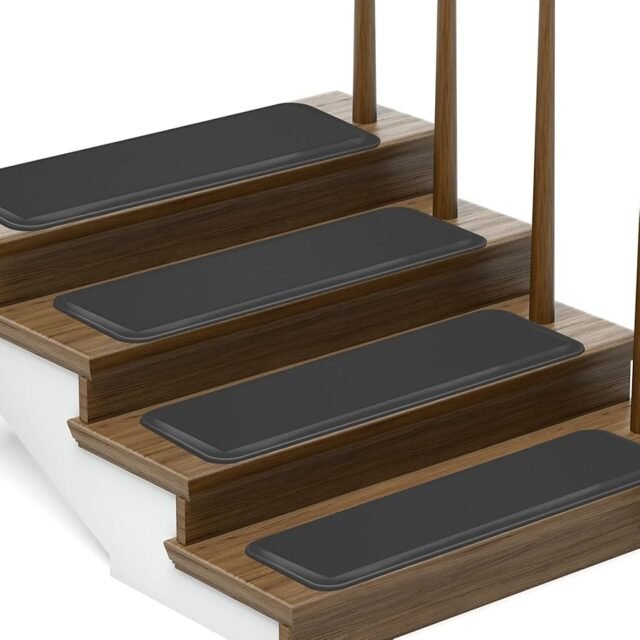Stair treads are more than the horizontal surfaces we walk on—they are the key to the safety, hardness, and beauty of any stairway. Regardless of your project, the new stair building or restoration of an existing one the right selection of Stair Treads material is crucial. From natural beauty to commercial hardness, stair tread material comes in a diverse range for use in a range of architecture, performance requirements, and budget constraints.
Wood Stair Treads
Wood is perhaps the most classic and adaptable material for stair treads. It has natural aesthetic appeal, a cozy look, and so many different types and finishes.
Popular Types of Wood Utilized
- Oak (White or Red): Durable, strong, and aesthetically pleasing.
- Walnut: Dark and sophisticated, commonly utilized in upscale residences.
- Pine: Lighter, less expensive, and best for low-traffic residential settings.
- Hickory and ash: hard and rough in appearance.
Advantages
- Aesthetic versatility (can be painted, sealed, or stained).
- Soft to tread on.
- Sustainable and renewable when responsibly harvested.
- Fairly easy to repair (scrapes can be sanded and refinished).
Disadvantages
- Will dent or scratch with time.
- Moisture sensitive unless well-sealed.
- Sporadic maintenance will be required.
Best Utilized For
Interior residences, interior staircases, traditional or rustic interiors, and where appearance is a factor.
Metal Stair Treads
Metal Anti Slip Stair Treads are highly regarded for their durability, long life, and sleek industrial appearance.
Common Metals Used
- Steel (galvanized or stainless): Durable, corrosion-proof, and can be engineered with anti-slip finishes.
- Aluminum: Lightweight, rust-proof, and well-suited for outdoor and marine applications.
- Cast Iron: Typically used in antique or cosmetic uses.
Advantages
- Very durable and abrasion resistant.
- Can be engineered with anti-slip texture or perforation.
- Ideal for heavy-usage or heavy-duty application.
- Low maintenance is needed.
Drawbacks
- It’s cold and difficult to walk on.
- Noisy when walked upon.
- Less warm in the eye than stone or wood.
Best Suited For
Industrial buildings, commercial properties, fire escapes, outdoor staircases, and sleek modernist aesthetics.
Concrete Stair Treads
Concrete is a durable and inexpensive material for stair treads, particularly in contemporary architecture and exterior environments.
Types
- Precast Concrete: Prefabricated off-site for easy installation.
- Poured-in-place Concrete: On-site adjustable for custom designs.
Strengths
- Extremely resilient and impact resistant.
- Fireproof and water-resistant.
- Can be shaped into many forms and textured for anti-slip safety.
- Durable with low maintenance.
Weaknesses
- Heavy and needs extensive structural support.
- Cold and unfriendly to be in residential areas.
- Cracks may develop without proper curing or reinforcement.
Best for
Exterior staircases, business buildings, minimalist and industrial architecture, basements, and cityscapes.
Composite Stair Treads
Composites are man-made products made from plastic, wood fibers, and other materials. They are commonly applied as an alternative for outdoor use and modern decks.
Typical Examples
- Wood-Plastic Composite (WPC)
- Fiberglass Reinforced Plastic (FRP)
Advantages
- Weather-resistant and moisture-proof.
- Low maintenance—does not need to be stained, painted, or sealed.
- Durable and resistant to splintering, cracking, and fading.
- Will usually include anti-slip surfaces.
Disadvantages
- More costly than pressure-treated wood.
- Less color and texture selection than natural wood.
Best Used For
Outdoor staircases, decks, porches, and weathered surfaces.
Stone Stair Treads
Natural stone treads, including granite, limestone, marble, and slate, offer an upscale and durable finish, usually applied in high-end or traditional architecture.
Advantages
- Upscale appearance and natural beauty.
- Weather-resistant and highly durable.
- Fire-resistant and low maintenance.
Disadvantages
- Heavy and costly.
- May be slippery when wet unless textured or treated.
- Must be sealed to be stain resistant.
Most Ideal For
Entryways, high-end homes, public buildings, and exterior decor.
Tile Stair Treads
Interior flooring can be replicated with ceramic or porcelain tiles installed on stair treads. They are versatile in design and are most utilized for warm climates.
Advantages
- Extensive choice of styles, colors, and patterns.
- Very durable and easy to maintain.
- Water- and stain-proof.
Disadvantages
- May be slippery unless textured.
- May crack or chip upon severe impact.
- Time-consuming to install.
Staircases for residential homes, restaurants, or hotels where continuity of design with the floor is desired. Read This
Things to Be Considered When Selecting Stair Tread Material
- Indoor vs. Outdoor: Outdoor steps will require weather-resistant materials such as metal, concrete, or composite.
- Residential vs. Commercial: Commercial areas require longer-lasting and code-compliant materials.
- Aesthetics: Think about whether the material will match your current décor and overall design style.
- Safety: Select materials with or apply non-slip coatings to reduce the risk of falls.
- Maintenance: Some materials require sealing, refinishing, or periodic cleaning.
- Cost: Budgetary constraints can dictate your choice wood and tile are mid-range, and glass and stone are high-end.








[…] You may also read: Materials for Stair Treads: Wood, Metal, and More […]
[…] they’re also made to keep you warm and comfortable. Most custom beanies are created using soft, durable materials like acrylic, cotton, or wool blends. These fabrics offer great insulation while staying breathable […]